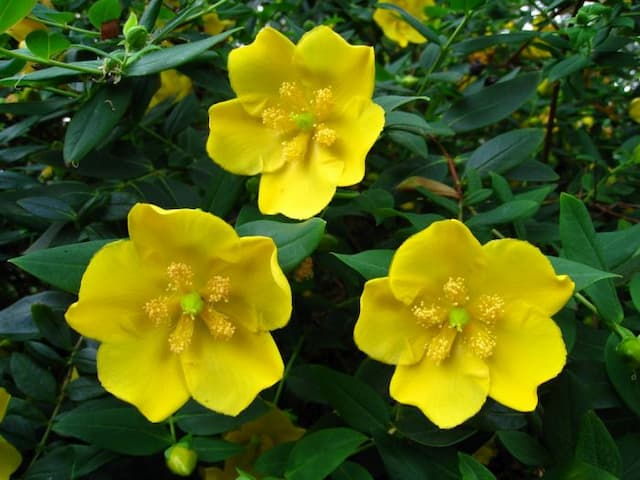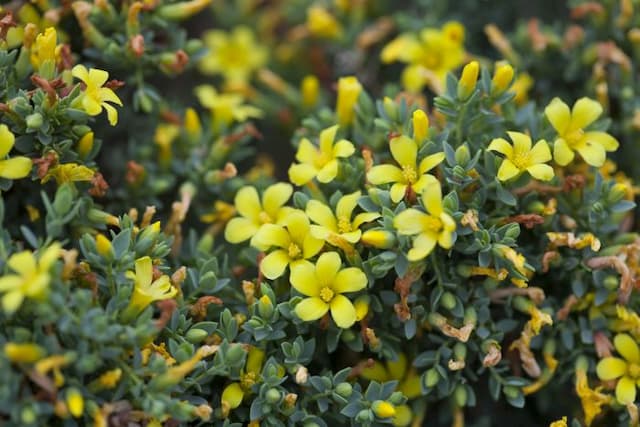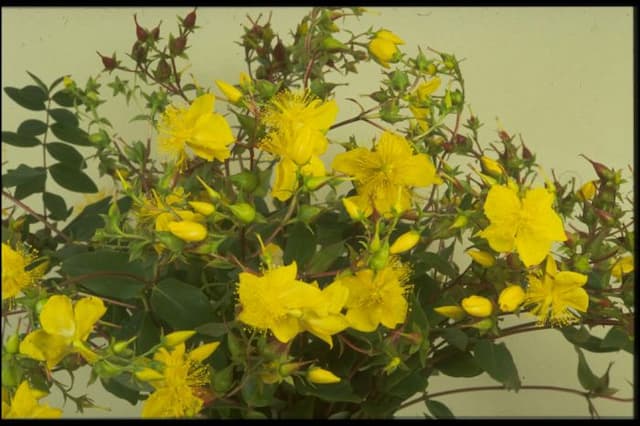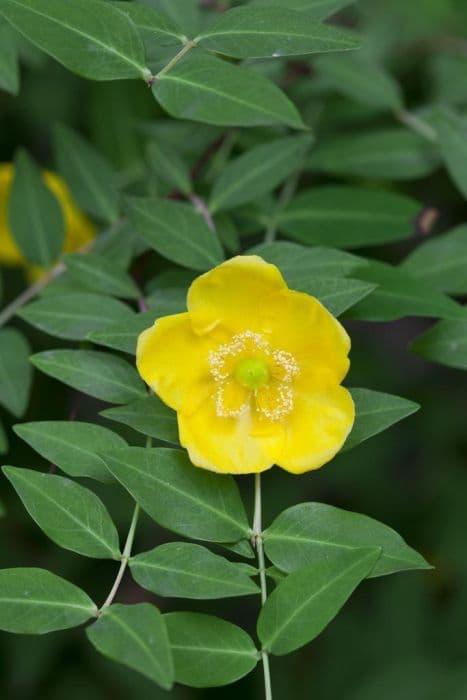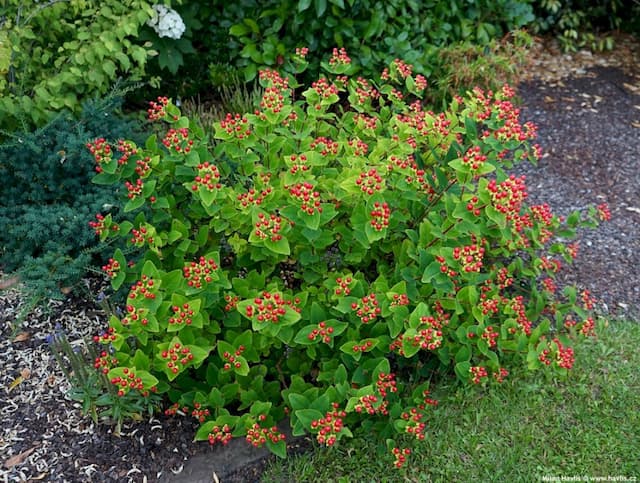St. John's Wort Hypericum monogynum

ABOUT
Hypericum monogynum, commonly known as Orange Hypericum, is a shrub-like plant characterized by its distinctive features. The plant showcases simple leaves that are arranged opposite each other along the stems. These leaves are often medium to dark green, providing a lush backdrop for the flowers. The foliage may also exhibit a slightly glossy appearance, adding to its visual appeal. The plant is renowned for its bright yellow flowers, which have a saucer-like shape and are centered with a prominent puff of stamens -- typically giving a bushy appearance. These yellow blossoms are a key attraction of Orange Hypericum and can add a pop of color to the green backdrop of leaves. After the flowering season, the plant may produce small, fleshy fruits that can range in color, but typically do not exceed the size of a small berry. Overall, the physical structure of Orange Hypericum is dense and bushy, allowing it to serve well as a decorative element in gardens and landscaping. It can often be found contributing to the undergrowth in garden compositions or used as a stand-alone feature due to its eye-catching flowers and attractive foliage.
About this plant
 Names
NamesSynonyms
St. John's Wort
Common names
Hypericum monogynum.
 Toxicity
ToxicityTo humans
The plant commonly known as St. John's Wort (Hypericum monogynum) has been used in herbal medicine for various purposes. However, it is important to note that while it has medicinal properties, the ingestion of St. John's Wort in large quantities can lead to serious side effects due to its toxicity. Symptoms of toxicity in humans may include gastrointestinal distress (such as nausea, vomiting, and diarrhea), fatigue, confusion, dizziness, and in severe cases, it can lead to photosensitivity—increased sensitivity to sunlight, which can cause skin irritation and increased risk of sunburn. The active compounds, such as hyperforin and hypericin, may interfere with various medications and could lead to serotonin syndrome if combined with other drugs that increase serotonin levels. Therefore, use should be under supervision and with appropriate dosing recommendations.
To pets
St. John's Wort is also toxic to pets, and cats and dogs can suffer from similar symptoms as humans if they ingest the plant. The symptoms of poisoning in pets include drooling, vomiting, and diarrhea, lethargy, and incoordination. Like in humans, St. John's Wort can cause photosensitivity in pets, which might manifest as sunburn-like symptoms on the skin—especially in areas with less fur. If you suspect your pet has ingested St. John's Wort, it is essential to seek veterinary care immediately, as it could lead to more severe complications without treatment.
 Characteristics
CharacteristicsLife cycle
Perennials
Foliage type
Evergreen
Color of leaves
Green
Flower color
Yellow
Height
1-3 feet (0.3-0.9 meters)
Spread
1-2 feet (0.3-0.6 meters)
Plant type
Shrub
Hardiness zones
5
Native area
Asia
Benefits
 General Benefits
General Benefits- Ornamental Value: Hypericum monogynum, commonly known as Saint John's Wort, is appreciated for its bright yellow flowers that can enhance the aesthetic appeal of gardens and landscapes.
- Low Maintenance: It is generally an easy-to-care-for plant that does not require extensive upkeep, making it suitable for beginner gardeners.
- Drought Tolerance: Once established, it has good drought tolerance, reducing the need for frequent watering.
- Adaptability: This plant can adapt to a range of soil types, although it prefers well-drained soils.
- Wildlife Attraction: The flowers of Saint John's Wort attract pollinators such as bees and butterflies, thereby supporting local ecosystems.
- Erosion Control: It can be used to stabilize soil and control erosion on slopes and banks.
- Ground Cover: With its spreading habit, it can be used as an effective ground cover to suppress weeds and cover bare soil.
 Medical Properties
Medical Properties- Antidepressant: Hypericum monogynum, commonly known as St. John's Wort, has compounds that may have an effect on neurotransmitters responsible for mood regulation.
- Antimicrobial: The plant exhibits antimicrobial properties against certain bacteria and viruses.
- Anti-inflammatory: It contains components that can help reduce inflammation in the body.
- Wound healing: Has been traditionally used to promote the healing of cuts and burns.
- Anxiolytic: It may have a mild anxiety-reducing effect.
 Air-purifying Qualities
Air-purifying QualitiesThis plant is not specifically known for air purifying qualities.
 Other Uses
Other Uses- Hypericum monogynum, commonly known as Gum plant, is sometimes used in floral arrangements for its bright yellow flowers and lush green foliage which add a vibrant touch to bouquets and decorations.
- The plant is considered a good option for ground cover in gardens due to its sprawling habit and attractive, low-maintenance growth which helps in reducing soil erosion and suppressing weeds.
- Indigenous cultures may use the Gum plant in various ceremonies and rituals for its symbolic significance representing cheerfulness and inspiration due to its lively flowers.
- The Gum plant can be used as a natural dye; the flowers and leaves can yield a range of colors from yellow to reddish tones when used in fabric dyeing processes.
- In some regions, the aromatic leaves of the Gum plant are used to impart a pleasant scent to linen and clothing when placed in drawers or closets.
- Gardeners often plant Hypericum monogynum as a companion plant because it can attract pollinators such as bees and butterflies to the garden, thereby supporting the pollination of neighboring plants.
- The dense foliage of the Gum plant can provide shelter and habitat for small wildlife, including beneficial insects and nesting materials for birds.
- Some crafters use the woody stems of Hypericum monogynum in creating rustic wreaths and other decorative items, where the stems lend a natural aesthetic to their handiwork.
- In landscapes, the Gum plant can be used to create a visually contrasting texture in mixed borders due to its unique form and foliage against larger-leaved plants.
- During autumn, when many plants begin to die back, the Gum plant can provide extended visual interest in the garden with its persisting structure and seed heads.
Interesting Facts
 Feng Shui
Feng ShuiThe St. John's Wort is not used in Feng Shui practice.
 Zodiac Sign Compitability
Zodiac Sign CompitabilityThe St. John's Wort is not used in astrology practice.
 Plant Symbolism
Plant Symbolism- Protection: Hypericum, commonly known as St. John's Wort, has been historically used to ward off evil spirits and negative energies.
- Healing: St. John's Wort is known for its medicinal properties, particularly in treating depression and wounds, symbolizing physical and emotional healing.
- Strength: The resilient nature of St. John's Wort, which makes it thrive in various conditions, represents inner strength and the ability to overcome challenges.
- Light: Associated with St. John the Baptist and celebrated on St. John's Day, this plant is symbolic of light and the triumph of good over evil, coinciding with the summer solstice.
 Water
WaterThe Saint John's Wort should be watered deeply but infrequently to encourage a strong root system. Generally, watering once a week with 1-2 gallons of water is sufficient, but this may vary depending on the climate and soil conditions. During hot or dry periods, increase watering to twice per week, always checking the soil moisture before doing so—it should be moist but not waterlogged. During winter or in cooler climates, reduce watering to prevent root rot. Ensure proper drainage to avoid standing water at the base of the plant.
 Light
LightSaint John's Wort thrives in full sun to partial shade. Ideally, it should receive at least 6 hours of direct sunlight daily, which promotes healthy flowering and growth. If planted indoors, place it near a window that receives ample sunlight throughout the day. It can tolerate slight shade, but prolonged lack of sunlight may result in fewer flowers and leggy growth.
 Temperature
TemperatureSaint John's Wort prefers moderate temperatures and can generally withstand temperatures between 50 to 90 degrees Fahrenheit. It can survive minimum temperatures down to about 10 degrees Fahrenheit but is best kept in conditions above freezing to avoid frost damage. The ideal temperature range for robust growth is between 60 to 75 degrees Fahrenheit.
 Pruning
PruningPrune Saint John's Wort annually to maintain its shape and encourage vigorous new growth. The best time for pruning is in late winter or early spring before new growth starts. Remove any dead or diseased wood and cut back up to one-third of the plant to stimulate fresh, healthy shoots. Frequent light trimming can also be done throughout the growing season to keep the plant tidy.
 Cleaning
CleaningAs needed
 Soil
SoilThe best soil mix for Aaron's beard, the common name for Hypericum monogynum, is one that is well-draining and rich in organic matter. A mix of peat, perlite, and garden soil can be suitable, ensuring good drainage while retaining moisture. The soil pH should range between 5.5 and 7 for optimal growth.
 Repotting
RepottingAaron's beard should be repotted every 1-2 years or when the plant becomes root-bound. It's best to repot in the spring as the plant enters a period of active growth, which helps it to quickly establish in the new potting medium.
 Humidity & Misting
Humidity & MistingAaron's beard thrives in moderate humidity levels. The best humidity level for this plant is around 40-60%. Unlike tropical plants, it does not require high humidity and can adapt to the average indoor humidity.
 Suitable locations
Suitable locationsIndoor
Provide bright, indirect light and well-draining soil for Aaron's beard indoors.
Outdoor
Plant Aaron's beard in partial sun to full shade in well-draining soil.
Hardiness zone
5-9 USDA
 Life cycle
Life cycleHypericum monogynum, commonly known as Gumplant, begins its life cycle with seed germination, occurring in favorable conditions of warmth and moisture. After germination, seedlings emerge and start the vegetative growth phase, developing a rosette of leaves at the soil surface. As the plant matures, it enters the flowering stage, typically in summer, producing yellow flowers that attract various pollinators for sexual reproduction. Following pollination, the flowers develop into capsules containing numerous small seeds. These seeds are then dispersed by various means, including wind and animals, to initiate a new generation. Finally, as a perennial, the Gumplant may enter a period of dormancy during the colder months, resuming growth with the onset of warmer weather.
 Propogation
PropogationPropogation time
Spring-Early Summer
Hypericum monogynum, commonly known as Shrubby St. John's Wort, can be propagated primarily by seed or softwood cuttings. The most popular method is using softwood cuttings, which are taken in late spring or early summer when the new growth is just hardening but still flexible. Cuttings should be about 4 to 6 inches (10 to 15 centimeters) long, with several leaves. The lower leaves are removed, and the cut end is often dipped in rooting hormone to encourage root development. Then, the cuttings are placed in a well-draining growing medium and kept under high humidity and indirect light until they root, which typically takes a few weeks. Once the cuttings have established a sufficient root system, they can be gradually acclimatized to ambient conditions and eventually transplanted to their final location.
